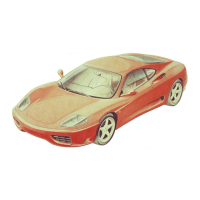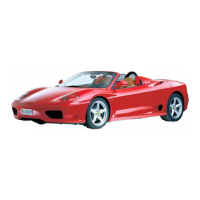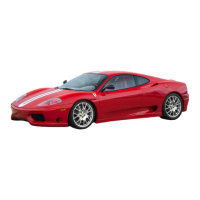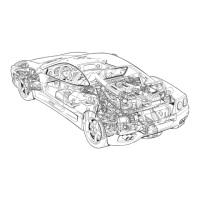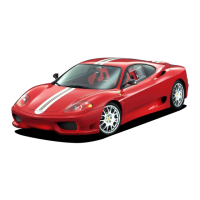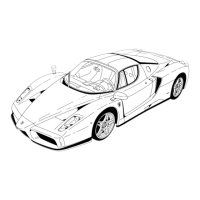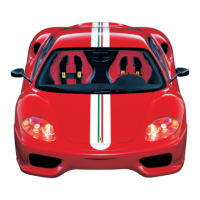Do you have a question about the Ferrari 2001 360 Spider and is the answer not in the manual?
Describes the unique design evolution of Ferrari 8-cylinder cars.
Explains how the manual is structured into sections and chapters for user-friendliness.
Advises using original Ferrari parts and lubricants to maintain warranty.
Details the F1 transmission system with levers and modes.
Describes the various plates related to vehicle homologation.
Details the various plates providing operating instructions.
Provides information on the vehicle's keys and their operation.
Explains the operation of exterior lights and turn signals via the steering wheel lever.
Details the function and operation of the turn indicators and their return mechanism.
Describes the different modes of operation for the windshield wipers.
Explains the operation of the headlight washing system.
Signals a fault with the ABS system, but the normal braking system remains functional.
Indicates insufficient brake or clutch fluid or excessive wear of front brake pads.
Describes the function of the parking brake.
Alerts to a malfunction in the AIR BAG system or seatbelt pre-tensioners.
Explains seatbelt usage and warnings, especially when the driver's seatbelt is not fastened.
Indicates issues with the recharging system or battery charge levels.
Signals a defect in the F1 transmission with an audible warning.
Signals a failure in the emission control system and ignition/injection systems.
Indicates when direction lights are activated or hazard lights are switched on.
Explains the operation of the dimmers or low beams.
Explains the operation of high beams and flashing.
Details how to activate the parking lights.
Describes the activation and automatic deactivation of the rear-view mirror defrosting.
Explains how to activate/deactivate SPORT mode, which changes driving characteristics.
Discusses the low grip mode for slippery conditions and its interaction with ASR.
Explains the icons displayed for car conditions and defects.
Indicates the system's self-check status and allows starting the engine.
Describes how to display the external temperature.
Explains the automatic window lowering during door opening/closing.
Details how to disable the alarm and central locking from the outside.
Describes how to release the door lock in an emergency.
Alerts the driver with an intermittent acoustic signal when the driver's door is open and ignition is off.
Details manual and automatic operation of the driver's side window.
Explains longitudinal adjustments for mechanical seats.
Describes how to adjust the seat back angle using the knob.
Describes manual positioning and anti-glare function.
Explains electrical adjustment and manual folding.
Details components like seatbelts, airbags, and body structure for crash protection.
Covers systems like braking, ASR, and climate control that prevent collisions.
Provides instructions on correctly fastening and adjusting seatbelts.
Describes the components of the airbag system, including cushions and control units.
Explains how the airbag system is activated and its basic functions.
Details the operation and safety precautions for the cigarette lighter.
Describes the location and function of the passenger-side vanity mirror.
Explains how to open the engine compartment hood.
Details the procedure for closing the engine compartment hood.
Describes how to open the hood in case of lever failure.
Explains how to open the luggage compartment hood.
Details the procedure for closing the luggage compartment hood.
Describes how to open the luggage compartment in case of button failure.
Explains how to open the fuel tank flap and unscrew the cap.
Details how to screw the cap back in and close the flap.
Describes how to open the fuel tank in case of button failure.
Provides important notes regarding top operation and care.
Lists the primary components of the convertible top system.
Indicates the state of the convertible top when closed.
Indicates the state of the convertible top when open.
Explains the operation of the convertible top's control system.
Lists the required conditions for opening or closing the convertible top.
Explains when an acoustic signal is activated during top operation.
Describes the procedure to restart the engine after a malfunction.
Describes the steps for the automatic opening sequence of the convertible top.
Lists the main components of the air conditioning system.
Explains the automatic and manual modes of the air conditioning system.
Identifies and describes the functions and controls for the air conditioning system.
Activates defogging and de-icing functions.
Controls airflow rate or turns off the system.
Provides instructions for the initial 1000 km of driving.
Outlines essential pre-trip checks and recommendations.
Offers guidance on safe driving practices, engine RPM, and warning lights.
Details starting the engine and driving with a manual transmission.
Explains starting the engine and system operation for F1 transmission.
Provides essential guidelines for parking the vehicle safely.
Offers advice on safe driving techniques and precautions.
Emphasizes responsible operation and environmental protection.
Lists the contents of the tool kit for emergency repairs.
Provides instructions for replacing a wheel, including safety precautions.
Details accessing and replacing front headlight bulbs.
Guides on identifying and replacing fuses.
Explains procedures for starting the car with an auxiliary battery.
Provides instructions for towing the vehicle using the tow hook.
Explains the automatic safety switch that cuts fuel supply in case of impact.
Describes the emergency spare tire and its specifications.
Notes that the car can be supplied with a spare wheel kit.
Explains the procedure for replacing high beam bulbs.
Explains how to replace the luggage compartment light.
Describes unscrewing knobs, removing bulb holders, and replacing bulbs.
Details unscrewing screws, removing the bulb holder, and replacing the bulb.
Guides on removing and replacing the ceiling light bulb.
Explains how to remove and replace the glove compartment light bulb.
Lists fuse colors corresponding to their amperage.
Lists colors for maxi fuses and their amperage.
Advises to disconnect the battery for prolonged inactivity.
Explains how to use an external battery for starting.
Advises using the correct attachment point for towing.
Explains how to reset the system after a collision.
Emphasizes the importance of maintaining the car for longevity and safety.
Refers to the booklet containing warranty regulations and maintenance records.
Outlines the need for regular maintenance at specified intervals.
Explains how to use the maintenance plan, referencing numbered operations.
Guides on checking fluid levels, such as engine oil.
Mentions battery specifications and maintenance-free nature.
Provides advice on proper usage and maintenance of wiper blades.
Offers instructions for tire use and checks.
Refers to procedures for adjusting headlight beams.
Provides guidelines for exterior and interior cleaning.
Outlines precautions for storing the car when unused for extended periods.
Details the procedure for checking engine oil level when the engine is warm.
Explains how to disconnect the battery using the master switch.
Provides guidelines for safely recharging the battery.
Describes the optional connector for a battery charger.
Guides on replacing wiper blades, including safety steps.
Provides essential guidelines for safe tire usage and checks.
Explains the procedure for applying wheel counterweights.
Offers recommendations for exterior car cleaning and precautions.
Provides key specifications for the engine.
Lists the gear ratios for the transmission.
Details acceleration and top speed figures.
Provides fuel economy estimates for city and highway driving.
Lists key dimensions and weights of the vehicle.
Specifies approved rim and tire sizes and pressures.
Lists components of the electrical system.
Details the types and quantities of fluids required for refilling.
Explains the function of supplying air to reduce emissions.
Describes the type and location of catalytic converters.
Lists the main electronic control units (ECUs) and their functions.
Explains the function of the phase sensor in engine timing.
Describes the air flow meter's role in engine management.
Explains the NTC sensor's function in monitoring coolant temperature.
Describes potentiometers that inform the ECU about throttle opening.
Explains the function and placement of detonation sensors.
Details the hydraulic control of the timing variator.
Explains the function of injectors spraying fuel into the intake duct.
Explains the sensor's role in detecting pedal position.
Guides on checking and replacing spark plugs.
Describes the fuel delivery system components.
Explains the automatic safety switch that cuts fuel supply in case of impact.
Describes the type and location of catalytic converters.
Explains the OBDII system for monitoring and diagnosing engine and emission systems.
Describes the dry, single-plate clutch with hydraulic release.
Explains that hydraulic control requires no pedal adjustment.
Locates the shared reservoir for clutch and brake fluid.
Details the shared lubrication system for gearbox and differential.
Lists key steering system specifications and features.
Describes the hydraulic steering system components and operation.
Lists the main components of the air conditioning system.
Describes the unit combining heating and cooling functions.
Describes the clutch system components.
Explains that the clutch does not require pedal adjustment.
Locates the shared reservoir for clutch and brake fluid.
Specifies the maximum allowable free travel for the brake pedal.
Explains the ABS as a safety device to prevent wheel lock-up.
Lists the main components of the ABS system.
Describes the self-diagnostic capabilities of the ECUs.
Explains the capability to connect to the SD-2 diagnostic system for remote diagnosis.
Describes the type and features of the shock absorbers.
Guides on checking and adjusting wheel alignment.
Lists the components of the electronic suspension control system.
Describes the self-diagnostic capabilities of the ECUs.
Explains the capability to connect to the SD-2 diagnostic system for remote diagnosis.
Describes the unique design evolution of Ferrari 8-cylinder cars.
Explains how the manual is structured into sections and chapters for user-friendliness.
Advises using original Ferrari parts and lubricants to maintain warranty.
Details the F1 transmission system with levers and modes.
Describes the various plates related to vehicle homologation.
Details the various plates providing operating instructions.
Provides information on the vehicle's keys and their operation.
Explains the operation of exterior lights and turn signals via the steering wheel lever.
Details the function and operation of the turn indicators and their return mechanism.
Describes the different modes of operation for the windshield wipers.
Explains the operation of the headlight washing system.
Signals a fault with the ABS system, but the normal braking system remains functional.
Indicates insufficient brake or clutch fluid or excessive wear of front brake pads.
Describes the function of the parking brake.
Alerts to a malfunction in the AIR BAG system or seatbelt pre-tensioners.
Explains seatbelt usage and warnings, especially when the driver's seatbelt is not fastened.
Indicates issues with the recharging system or battery charge levels.
Signals a defect in the F1 transmission with an audible warning.
Signals a failure in the emission control system and ignition/injection systems.
Indicates when direction lights are activated or hazard lights are switched on.
Explains the operation of the dimmers or low beams.
Explains the operation of high beams and flashing.
Details how to activate the parking lights.
Describes the activation and automatic deactivation of the rear-view mirror defrosting.
Explains how to activate/deactivate SPORT mode, which changes driving characteristics.
Discusses the low grip mode for slippery conditions and its interaction with ASR.
Explains the icons displayed for car conditions and defects.
Indicates the system's self-check status and allows starting the engine.
Describes how to display the external temperature.
Explains the automatic window lowering during door opening/closing.
Details how to disable the alarm and central locking from the outside.
Describes how to release the door lock in an emergency.
Alerts the driver with an intermittent acoustic signal when the driver's door is open and ignition is off.
Details manual and automatic operation of the driver's side window.
Explains longitudinal adjustments for mechanical seats.
Describes how to adjust the seat back angle using the knob.
Describes manual positioning and anti-glare function.
Explains electrical adjustment and manual folding.
Details components like seatbelts, airbags, and body structure for crash protection.
Covers systems like braking, ASR, and climate control that prevent collisions.
Provides instructions on correctly fastening and adjusting seatbelts.
Describes the components of the airbag system, including cushions and control units.
Explains how the airbag system is activated and its basic functions.
Details the operation and safety precautions for the cigarette lighter.
Describes the location and function of the passenger-side vanity mirror.
Explains how to open the engine compartment hood.
Details the procedure for closing the engine compartment hood.
Describes how to open the hood in case of lever failure.
Explains how to open the luggage compartment hood.
Details the procedure for closing the luggage compartment hood.
Describes how to open the luggage compartment in case of button failure.
Explains how to open the fuel tank flap and unscrew the cap.
Details how to screw the cap back in and close the flap.
Describes how to open the fuel tank in case of button failure.
Provides important notes regarding top operation and care.
Lists the primary components of the convertible top system.
Indicates the state of the convertible top when closed.
Indicates the state of the convertible top when open.
Explains the operation of the convertible top's control system.
Lists the required conditions for opening or closing the convertible top.
Explains when an acoustic signal is activated during top operation.
Describes the procedure to restart the engine after a malfunction.
Describes the steps for the automatic opening sequence of the convertible top.
Lists the main components of the air conditioning system.
Explains the automatic and manual modes of the air conditioning system.
Identifies and describes the functions and controls for the air conditioning system.
Activates defogging and de-icing functions.
Controls airflow rate or turns off the system.
Provides instructions for the initial 1000 km of driving.
Outlines essential pre-trip checks and recommendations.
Offers guidance on safe driving practices, engine RPM, and warning lights.
Details starting the engine and driving with a manual transmission.
Explains starting the engine and system operation for F1 transmission.
Provides essential guidelines for parking the vehicle safely.
Offers advice on safe driving techniques and precautions.
Emphasizes responsible operation and environmental protection.
Lists the contents of the tool kit for emergency repairs.
Provides instructions for replacing a wheel, including safety precautions.
Details accessing and replacing front headlight bulbs.
Guides on identifying and replacing fuses.
Explains procedures for starting the car with an auxiliary battery.
Provides instructions for towing the vehicle using the tow hook.
Explains the automatic safety switch that cuts fuel supply in case of impact.
Describes the emergency spare tire and its specifications.
Notes that the car can be supplied with a spare wheel kit.
Explains the procedure for replacing high beam bulbs.
Explains how to replace the luggage compartment light.
Describes unscrewing knobs, removing bulb holders, and replacing bulbs.
Details unscrewing screws, removing the bulb holder, and replacing the bulb.
Guides on removing and replacing the ceiling light bulb.
Explains how to remove and replace the glove compartment light bulb.
Lists fuse colors corresponding to their amperage.
Lists colors for maxi fuses and their amperage.
Advises to disconnect the battery for prolonged inactivity.
Explains how to use an external battery for starting.
Advises using the correct attachment point for towing.
Explains how to reset the system after a collision.
Emphasizes the importance of maintaining the car for longevity and safety.
Refers to the booklet containing warranty regulations and maintenance records.
Outlines the need for regular maintenance at specified intervals.
Explains how to use the maintenance plan, referencing numbered operations.
Guides on checking fluid levels, such as engine oil.
Mentions battery specifications and maintenance-free nature.
Provides advice on proper usage and maintenance of wiper blades.
Offers instructions for tire use and checks.
Refers to procedures for adjusting headlight beams.
Provides guidelines for exterior and interior cleaning.
Outlines precautions for storing the car when unused for extended periods.
Details the procedure for checking engine oil level when the engine is warm.
Explains how to disconnect the battery using the master switch.
Provides guidelines for safely recharging the battery.
Describes the optional connector for a battery charger.
Guides on replacing wiper blades, including safety steps.
Provides essential guidelines for safe tire usage and checks.
Explains the procedure for applying wheel counterweights.
Offers recommendations for exterior car cleaning and precautions.
Provides key specifications for the engine.
Lists the gear ratios for the transmission.
Details acceleration and top speed figures.
Provides fuel economy estimates for city and highway driving.
Lists key dimensions and weights of the vehicle.
Specifies approved rim and tire sizes and pressures.
Lists components of the electrical system.
Details the types and quantities of fluids required for refilling.
Explains the function of supplying air to reduce emissions.
Describes the type and location of catalytic converters.
Lists the main electronic control units (ECUs) and their functions.
Explains the function of the phase sensor in engine timing.
Describes the air flow meter's role in engine management.
Explains the NTC sensor's function in monitoring coolant temperature.
Describes potentiometers that inform the ECU about throttle opening.
Explains the function and placement of detonation sensors.
Details the hydraulic control of the timing variator.
Explains the function of injectors spraying fuel into the intake duct.
Explains the sensor's role in detecting pedal position.
Guides on checking and replacing spark plugs.
Describes the fuel delivery system components.
Explains the automatic safety switch that cuts fuel supply in case of impact.
Describes the type and location of catalytic converters.
Explains the OBDII system for monitoring and diagnosing engine and emission systems.
Describes the dry, single-plate clutch with hydraulic release.
Explains that hydraulic control requires no pedal adjustment.
Locates the shared reservoir for clutch and brake fluid.
Details the shared lubrication system for gearbox and differential.
Lists key steering system specifications and features.
Describes the hydraulic steering system components and operation.
Lists the main components of the air conditioning system.
Describes the unit combining heating and cooling functions.
Describes the clutch system components.
Explains that the clutch does not require pedal adjustment.
Locates the shared reservoir for clutch and brake fluid.
Specifies the maximum allowable free travel for the brake pedal.
Explains the ABS as a safety device to prevent wheel lock-up.
Lists the main components of the ABS system.
Describes the self-diagnostic capabilities of the ECUs.
Explains the capability to connect to the SD-2 diagnostic system for remote diagnosis.
Describes the type and features of the shock absorbers.
Guides on checking and adjusting wheel alignment.
Lists the components of the electronic suspension control system.
Describes the self-diagnostic capabilities of the ECUs.
Explains the capability to connect to the SD-2 diagnostic system for remote diagnosis.
| Brand | Ferrari |
|---|---|
| Model | 2001 360 Spider |
| Category | Automobile |
| Language | English |
